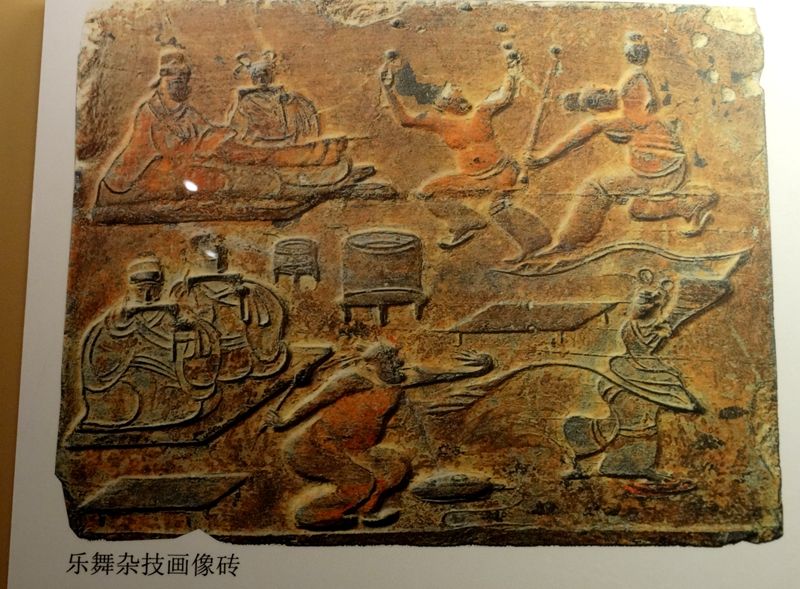Diversified Juggling Acrobatics
4 min readDiffering from strength acrobatics and physique skills, the juggling acrobatics is the performing art following the objects’ motion law. The most common juggling acrobatic shows are “juggling balls”,”juggling swords”,”juggling both balls and swords”and”whirling dishes”.
“Juggling balls”, also called”flying or jumping balls”in the Han dynasty, was a game played with little balls. In the Han dynasty such a game was quite popular as reflected in almost all of the acrobatic pictures. Juggling balls may be performed by a single hand or both hands and the balls may be pitched horizontally orvertically. The portrait on the brick unearthed from Mountain Yangzi, Sichuan Province depicts the performer pitching the balls horizontally. And the stone portrait at Guojushi of Mountain Xiaotang in Shandong Province depicts the performer pitching the balls vertically. By the Han dynasty the art of juggling balls assumed new features as the balls involved in the game were no longer the same in both weight and size, which rendered the performance even harder to execute. What’s more, the balls were not to be caught by the hand only since the shoulder, the instep or the bottom might play a role in catching the balls. The juggler constantly ad justed his gestures and postures to ensure different parts of his body could catch theballs, thus the acrobatic shows of juggling balsa took more colorful and amusing forms.

“Jumping swords”is similar to “juggling balls”only that the objects involved in two games are different, but the former is much more demanding. Juggling balls requires catching the balls while jumping swords requires catching the handles of the swords. There was some risk in jumping swords as the slight negligence on the part of the performer might incur wounds and pain upon the performer himself, so there were not so many acrobats devoted to jumping the swords. The scenes of jumping swords do not occur as frequently as those of juggling balls in the paintings of the Han dynasty. In the scene depicting the art of jumping swords, the involved swords number three or four. No finding indicates that someone in the Han dynasty could emulate Lanzi in the Eastern Zhou dynasty to handle seven swords. Among all the portraits the stone carving at Yinan is most vivid in depicting jumping swords. In the picture of variety shows at Yinan an elder squats with his head upward; he holds a sword in one hand and just pitches a sword from the other hand; his eyes are riveted on his ball while behind his back are five mottled little balls which bear small holes. In pitching and catching such little balls air passes through the small holes in the balls, producing pleasant sounds, thus the little balls are called “jingling balls”.
Juggling both balls and swords was developed by combining juggling balls and jumping swords. The objects tossed and caught in such acrobatic shows were not limited to the balls, but included the cutlasses as well. As objects different in weight and shape were involved in the game, it was more challenging for the performer to handle the game. But in Licheng, Shandong Province an image of a performer juggling four balls and jumping three swords has been found on a stone portrait at the Golden Temple, which gives a hint that the acrobatic art of juggling balls and jumping swords attained a very high level.

Greatly different from juggling balls and jumping swords, whirling dishes belongs to another category of juggling acrobatics. As for whirling the dishes, set the properly treated bamboo spike under the dish and twist the spike to set the disl swirling. Some murals at Taizi Village in Liaoyang depict this acrobatic art. The performer gets down to the ground on a single knee, holds up a bamboo spike in either hand, lifts his head with his eyes focused on the swirling dishes. Certainly whirling dishes is not limited to such a form. Some performers whirl dishes on thei palms. Some bronze ornaments excavated in Yunnan Province feature two performers swirling dishes with both hands. In the Han Dynasty one performer handled only one dish while in modern times one performer handles as many as six dishes or even twelve dishes. Whirling dishes is executed in varied patterns. In the Han dynasty the performers put the swirling dish atop the bamboo spike on their forehead andmade sure the dish kept swirling, which demanded the performers to have excellent command of the speed and balance of the swirling dishes as well as keen knowledge about the balancing spots between the spike and the dish and those between the spik and the forehead.

In addition to the above-mentioned performances, the juggling acrobatics also encompass other items such as Nong Ping Bian Ji, pitch-pot games, ball dancing and so on, which were very popular in the Han dynasty. Some other acrobatic shows combined juggling skills with a variety of other techniques. In the stone portrait at Mountain Wei, Shandong Province is one performer juggling balls and striding across a lying acrobat. Besides the stone portrait excavated from the tomb of the Eastern Han dynasty at the Octagonal Glazed Well in Jining, Shandong Province features a performer tossing a ball then catching it by his foot. This is a vivid reflection of the performer’s high proficiency in the art and makes spectators overwhelmed with admiration. In a word in the large family of acrobatics the juggling skills boast the most varieties, which occupied a significant position in the acrobatics in the Han dynasty.








